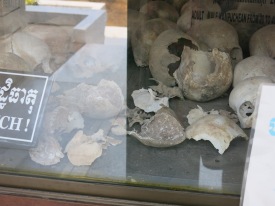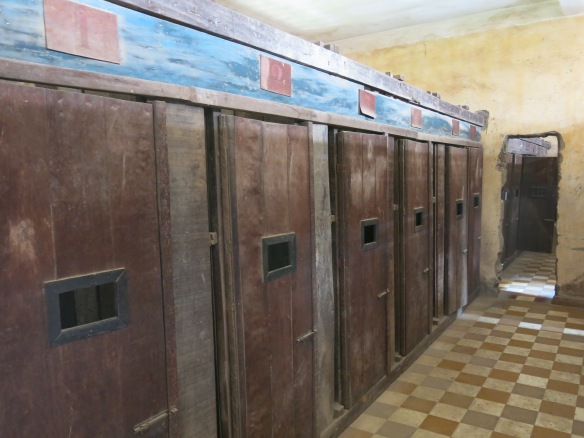Two places I knew I needed to visit in Phnom Penh were the Choeung Ek Memorial (Killing Fields) and the Tuol Sleng Genocide Museum (aka S-21), and yes, they’re as depressing as they sound.

First off, if you don’t know much about the Khmer Rouge, I recommend looking into it a little bit. It’s been interesting to learn about what happened in Cambodia under the Khmer Rouge, and I think it’s a shame that it was never taught in history class. And it’s the same among most other traveler’s I meet from around the world…none of us were ever taught anything about this period and the atrocities that were committed.
The short history is that the Khmer Rouge was the ruling party in Cambodia from 1975 to 1979. Their goal was to create a communist, agrarian society, and remove any non-Khmer from the country, especially Vietnamese and Chinese. To achieve this, they started by evacuating cities (when Phnom Penh was initial cleared out, the convinced everyone to leave by telling them there were reports the US was going to bomb it any day) and moved everyone to the countryside to work on farms. They shut down schools and hospitals, closed businesses, and eliminated banks and currency. Teachers, books, and religion became a thing of the past. Intellectualism would get one killed.
If the Khmer Rouge had even the slightest worry that a person opposed them, they were killed for it. Having a formal education, speaking another language, previously working for the government, wearing glasses, and having uncallused hands were all grounds for being sent to the killing fields. And once there, all hope was lost.
When I arrived at the killing fields, I was surprised by how small it was…6 acres. I was expecting something similar to a concentration camp, but here they had no need for any facilities or rows and rows of barracks. When victims arrived here, they were unloaded from the truck, murdered, and thrown into mass graves. At the center of the killing field, they had massive speakers hanging from a large tree. All day, the speakers blasted music and propaganda, which drowned out the screams of the victims, keeping anyone living nearby unaware of what was going on.
By the time the Khmer Rouge fell in early 1979, they had killed somewhere around 2 million Cambodians (at a time when the population of Cambodia was only 8 million)
Bones and scraps of clothes are still working their way to the surface


The memorial at the center of the field is filled with the bones of victims from the site.




Guns were typically not used during the executions, as bullets were scarce. People were usually killed with blunt objects (hammers, shovels, clubs) and knives. And when the soldiers got tired of having to keep their knives sharp enough, they often resorted to using the sharp, serrated edges of palm branches

By far, the worst part of the visit was this…the killing tree. When non-Khmer Rouge troops first came into the killing field, they found this tree, covered in hair and blood. When they later excavated the grave next to it, they found the bodies of over 100 women and children. To kill the small children, they’d hold them by the feet and smash their head against the tree before throwing them into the pit next to it.

If that wasn’t bad enough…just to really show how shitty a human can be, two quotes from Pol Pot, leader of the Khmer Rouge.
“Better to kill an innocent by mistake than spare an enemy by mistake.”
“To keep you is no gain, to lose you is no loss”
After going to the Killing Fields, the depression continued with a visit to Tuol Sleng (which translates to Strychnine Hill).




The site was originally a high school, but in 1975 the Khmer Rouge shut it down and converted it to Security Prison 21, where prisoners were interrogated, tortured, and executed. In the middle of the schoolyard was a pull-up bar. During it’s time as a prison, the pull-up bar was used for torture. A victim’s hands would be tied behind his or her back, and the rope would then be pulled over the bar, lifting them off the ground. When the pain was bad enough that the victim would pass out, they’d be dropped to the ground, have their head dunked in sewage to wake them back up, and it would start all over again.
A tiny sample of all the photos of the victims of S-21

Shackles that were used in the prison cells

And that’s about all I could handle for the day.






Thanks for covering this Pat…as sick as it makes me feel to read about this horrific part of human history, and to even see this site through the lens of your camera, I cannot fathom how it was for those who were forced to endure these atrocities, and whose family and friends who are reminded often, if not daily…
Even so Pat, I want to personally Thank you for sharing so much culture, history, and even beauty, through your personal adventure journey…through your pictures and writings, many of us have been able to experience another portion of this world. Be blessed…s
I always remember the sentence “reality surpasses fiction”, but when I see this story, is so sad. Lot of people, lot of lives, broken by a stupid decision taken by stupid people. I also think that this kind of thing should be taught in every school on the earth, because it NEVER should happen again. So sad…